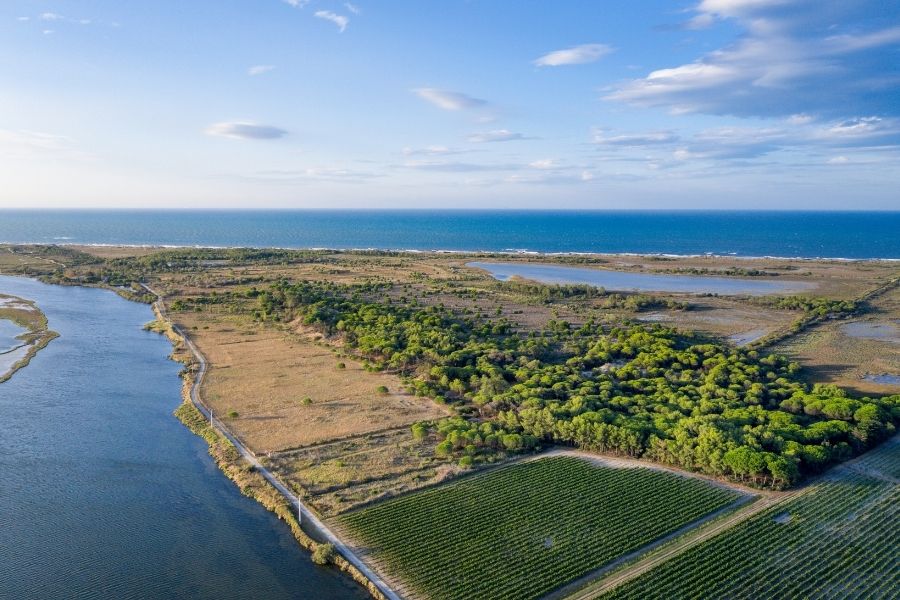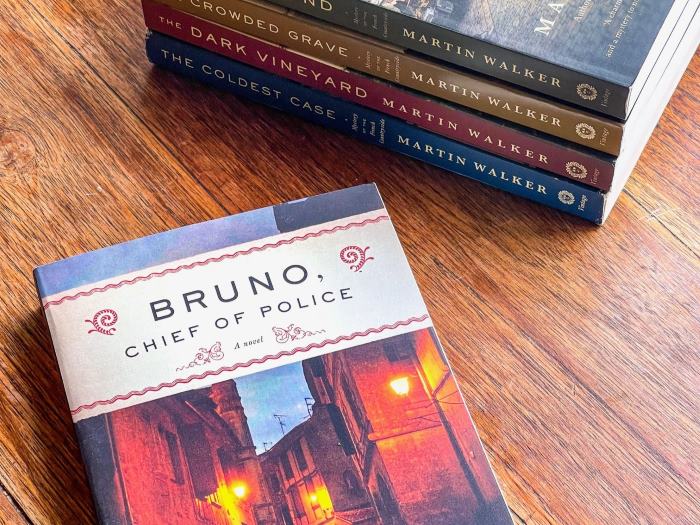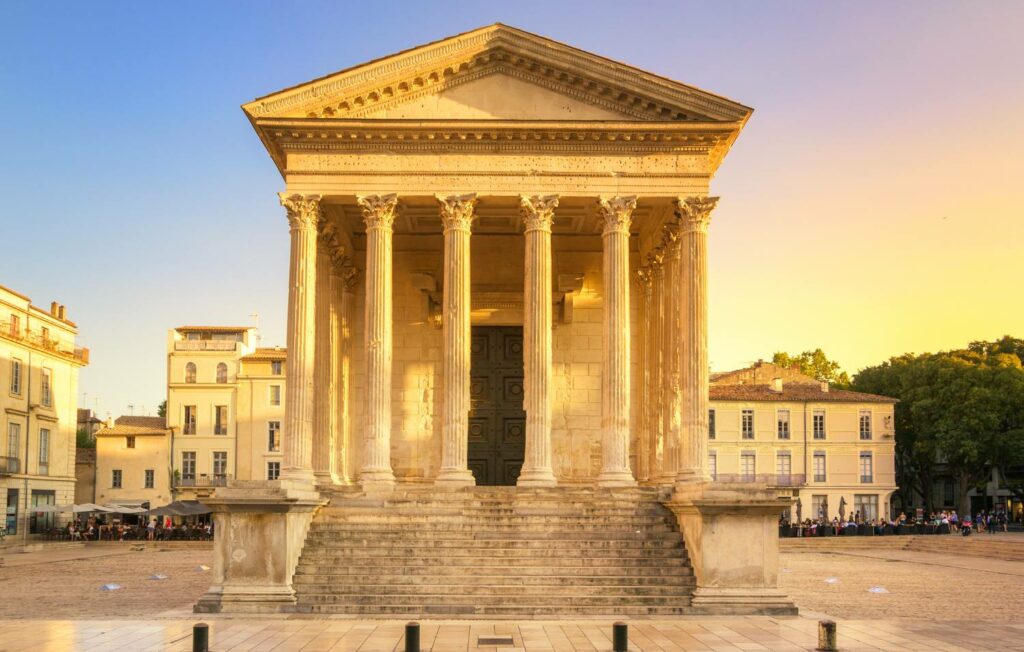Last update:
The History & Significance of Lavender in Provence

Envision yourself wandering through rows of vibrant purple lavender, the floral scent gently floating on the breeze, listening to the sound of the cicadas as you gaze out over the mesmerizing landscape. This serene scene is real life in Provence, a region renowned for its rich culture, delectable cuisine, and breathtaking natural beauty.
More than just a pretty postcard picture, the lavender is an integral part of the Provençal way of life. Working the lavender has been a tradition here for centuries, with many small farms harvesting the flower today to produce perfumes, essential oils, soaps, and other lavender derived products. The care and effort the locals put into cultivating the iconic crop reflects their pride in regional traditions.
In this blog post, we invite you to journey through Provence to uncover the history and cultural significance of lavender in Provence, its wide array of applications and highlight the blend of activities and festivities that honor it. Whether you are a devoted aficionado of lavender or a traveler fueled by curiosity, this guide promises inspiration for your next adventure among the lavender fields of Provence.
The Origins of Lavender Use
Lavender’s journey traces back millennia, with its roots deeply embedded in the Mediterranean region and the Middle East. Its aromatic and medicinal qualities captured the attention of ancient civilizations, notably the Egyptians, who utilized lavender over 2,500 years ago for mummification rites and perfumes.
The Romans further embraced lavender, integrating it into their daily lives as a symbol of cleanliness and healing. Lavender became a staple in Roman baths, where its fragrant essence infused the waters, providing a sense of relaxation and purification.
The first written record of lavender’s medicinal properties can be attributed to Dioscorides, a Greek military physician serving under Emperor Nero in 77 AD. Dioscorides chronicled lavender’s diverse applications in his work “De Materia Medica,” detailing its effectiveness in alleviating indigestion, headaches, and sore throats when ingested, as well as its role in wound care and burn treatment when applied topically. In fact, Roman soldiers took lavender on campaigns with them to dress war wounds.
The Romans also coined its botanical name, lavandula, some say that it is derived from “lavare,” the Latin term for “to wash.”
Despite its prominence in Roman times, lavender’s usage waned during the Dark Ages, finding refuge primarily in the gardens of monasteries tended by monks and nuns. Monastic communities preserved ancient herbal knowledge, recording lavender’s therapeutic properties and reaffirming its status as a healing herb.
The Renaissance period witnessed a resurgence of interest in lavender, with notable herbalists such as Gerard, Parkinson, and Culpepper extolling its virtues in their writings. Lavender’s reputation as a panacea flourished, with street vendors peddling its remedies, especially during the Great Plague of 1665, when it was believed to safeguard against disease.


Cultural and Economic Impact on the Region
The journey of lavender from a medicinal garden plant to a lucrative commercial commodity unfolded in the 18th century with the creation of the corporation of master perfumers in Grasse in 1759. Grasse, known as the perfume capital of the world, became a hub for lavender processing and perfume production.
Nurtured by the rugged terrain of Provence, lavender found a haven in the region’s harsh climate and rocky soil. Its wild proliferation mirrored the resilience of the Provencal landscape, fostering a symbiotic relationship that would shape the region’s identity for centuries to come.
This industry became deeply rooted in the seasonal rhythms and the familial way of life of Provence, often engaging women in its practices. Initially, it was the local shepherds and peasants who gathered this wild lavender. In 1920, the production of lavender essential oil had reached 70 tons, with 90% sourced from wild harvesting and 10% from cultivated lavender. But by 1960, the production of lavender essential oil rose to 130 tons, with 90% now coming from cultivated lavender and only 10% from the wild. Lavender farming became a cornerstone of the region’s economy, providing livelihoods for many and reinforcing its cultural identity as the heartland of lavender production.
This shift in production carpeted the landscape with lavender fields, contributing to Provence’s iconic imagery and scent captivating artists, writers, poets and visitors alike.
Traditional Uses of Lavender
Lavender boasts a diverse array of practical and medicinal applications, making it a cherished treasure in Provence. Renowned for its versatility, this fragrant herb finds its way into an assortment of products, from soothing teas and luxurious perfumes to invigorating essential oils and delectable confections.
With its natural antiseptic and anti-inflammatory qualities, it offers a soothing remedy for headaches, sleeplessness, and bug bites. Beyond its therapeutic qualities, lavender encapsulates the quintessential Provençal lifestyle, seamlessly integrating into daily routines as a decorative embellishment, culinary accent, and indispensable component in aromatherapy.
Moreover, the humble lavender sachet stands as a loyal guardian, warding off mites from drawers and closets, infusing a touch of Provence’s natural charm into every corner of the home.
Lavender is truly a gift from nature, for its ability to enhance our well-being and bring contentment to in our daily lives.
Lavender in Cuisine: A Taste of the Region
Lavender’s appeal transcends the visual and olfactory—it’s also a culinary treasure. Employed as a herb, spice, flavoring, and decoration, lavender can elevate a variety of dishes, from the simplicity of salads to the richness of meats and sweets. Whether in teas, lemonades, syrups, or liqueurs, lavender adds a distinct regional touch that’s integral to Provencal gastronomy. Discover and indulge in the many lavender-infused delicacies throughout Provence.

- Lavender honey: A renowned and delectable treasure of Provence, lavender honey is born from the nectar of lavender flowers. It carries a gentle floral aroma coupled with a sweet taste. Ideal for sweetening tea, yogurt, or cheese, and perfect for creating scrumptious desserts like cakes, cookies, ice cream, or nougat.
- Lavender infused honey: Different from the lavender honey, this one is infused with dried lavender flowers giving it a stronger flavor.
- Lavender cheese: A Provencal delight, lavender cheese fuses fresh goat cheese with the essence of lavender flowers. It boasts a creamy texture and a distinct hint of lavender.
- Lavender ice cream: What better way to cool down on a hot summer day than with some Lavender ice cream? Stop at one of the ice cream booths on the side of the road during your trip through Provence to indulge in this delicious regional treat.
The Art and Craft of Lavender in Provence
Lavender also fosters artistic expression and craftsmanship in Provence. The region boasts a wealth of art and crafts; incorporating flowers, stems, leaves, and oil into exquisite creations. Common crafts include lavender wands, dolls, baskets, wreaths, and sachets.
During your trip to Provence make time to visit a local market or small boutiques to admire the talent of local artists and artisans through their paintings, pottery, jewelry and other creations.


Experience Lavender Beyond Sight: Workshops and Festivals
Lavender offers a delightful experience that touches all senses, not just your sight. Delving into the world of this fragrant plant, you’ll discover its essence—whether you’re engaging in workshops on how it’s transformed into oil or savoring its unique taste. Explore the range of enchanting experiences in the heart of Provence.
Annual Lavender Festivals and Celebrations
In the full bloom of summer, Provence bursts into celebration with its annual lavender festivals. Immerse yourself in an atmosphere charged with music, dance, and the arts—all tributes to this iconic flower. Participate in hands-on activities, from crafting lavender bouquets to joining vibrant parades. Here are some of the most known lavender festivals in Provence:
– Ferrassieres: 1st Sunday of July
– Lavandissima in Le Thor: 2nd Saturday of July
– Valensole: 3rd Sunday of July
– The Lavender Corso of Digne-les-Bains: 1st Sunday of August
– Sault: August 15th
You can read more about these festivals here.
Lavender Distillation Demonstrations
Discover the process of lavender distillation on farms and in museums throughout Provence. Here, traditional methods breathe life into the essential oils that define this region’s heritage. Engage with the history and precise techniques used over generations, while seizing the chance to bring home exquisite lavender-infused goods like soaps, perfumes, and lotions. Joining a “make your own lavender essential oil to take take home” experience is the perfect way to complete your trip.



Tips for Planning Your Lavender Field Visit
The Lavender Routes stretch for nearly 1000 km offering the most vibrant vistas from mid-June to late July depending on where you go. Traversing these paths will lead you from the Alps deep into the heart of the Luberon, revealing expanses of lavender and lavandin—the latter being a hardier hybrid variant, famed for its oil production. Along the way, the journey is peppered with quaint villages, historical landmarks, and picturesque views.
To enhance your experience, consider the following advice:
- Rent a car or sign up for a guided tour to navigate the fields with ease. Given the expansive area and sparse public transport, having your own vehicle or tour guide can enrich your exploration.
- Stay vigilant about the weather. The summer heat in Provence can be intense; staying hydrated, applying sunscreen, and wearing a hat are essentials. We recommend exploring the fields in the morning.
- Show respect for local farmers and the environment. These fields are not just beautiful—they’re also the farmers’ livelihood. Make sure to get permission before entering any fields, refrain from picking lavender, and leave no litter. You’re welcome to take photos at the edge of the fields or from specific viewpoints.
If your heart is set on witnessing the mesmerizing lavender fields, it’s never too early to start planning your journey. Consult our other blog to know where and when to see the lavender in Provence to pinpoint the ideal time and locations for the most breathtaking blooms. Plus, consider enhancing your experience with a guided tour or a workshop to delve into the intricacies of lavender distillation.








